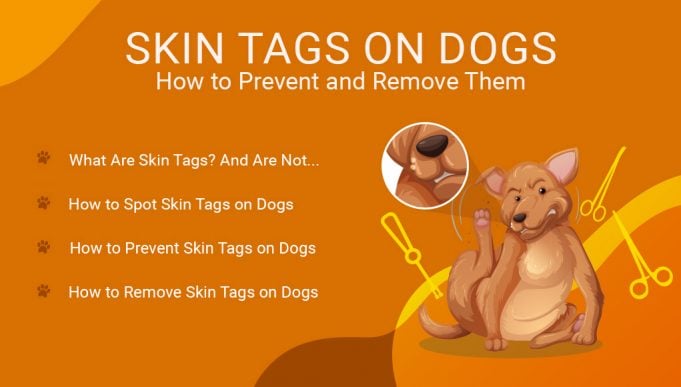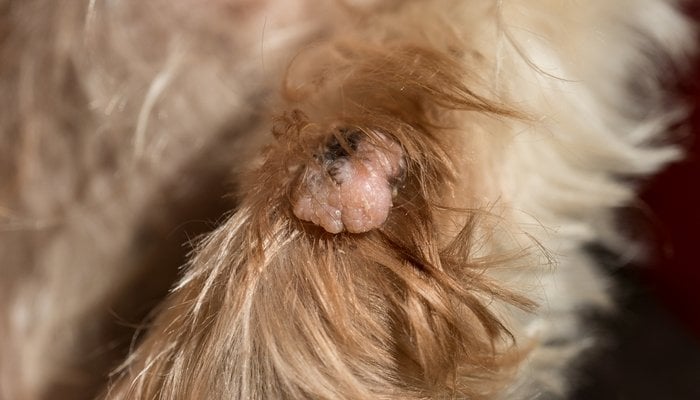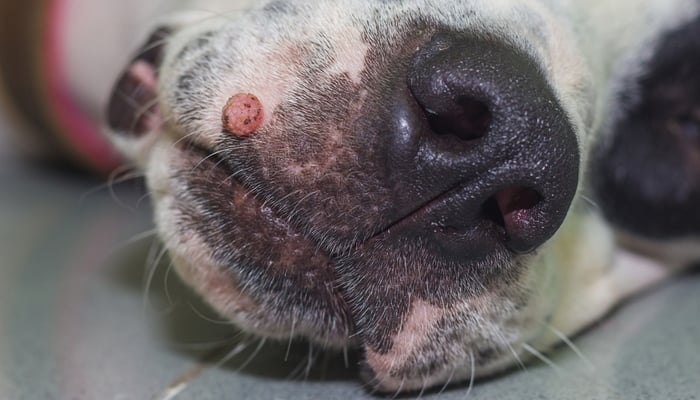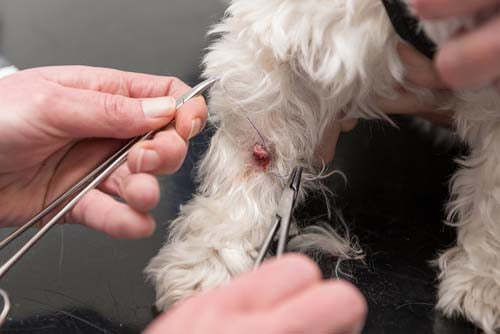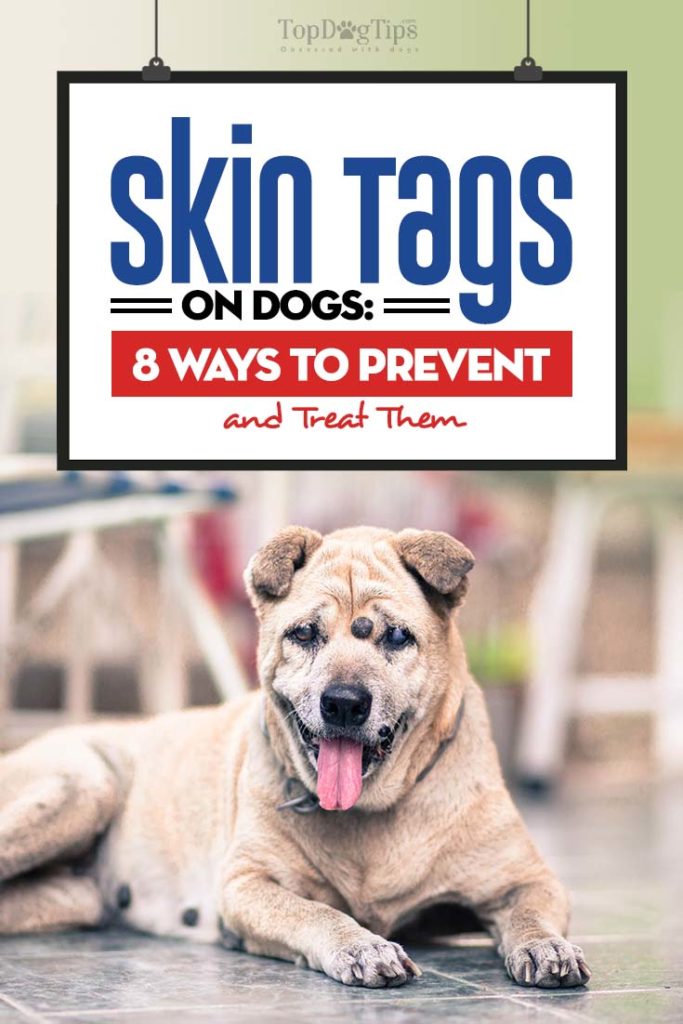Table of Contents
Skin tags are small, benign growths that can appear on any dog of any breed, gender, and age.
Some breeds are more susceptible to skin tags, and certain environmental factors can also play a role.
Even if these growths are harmless, there are a few things all pet owners must know about skin tags on dogs and what to do (or not do) about them.
What Are Skin Tags?
Skin tags are also known as papillomas, skin polyps, and acrochordons.
They are benign tumors that can appear as fleshy growths anywhere on your dog’s body.
Occurring in different shapes and sizes, most often, they are only millimeters long.
This is what a skin tag on a dog looks like:
There are a few types of skin tags that dogs can get:
- Fibroadnexal hamartomas
- Fibrovascular papillomas
- Fibroepithelial polyps
- Hyperplastic/hypertrophic scarring
- Collagenous hamartoma
Fibroadnexal hamartomas are probably the most common.
They are usually hairless and are found by pressure points and the lower limbs.
Follicular hamartomas are a subtype of the first and much rarer.
They tend to be flattened masses with hair and come in multiples.
A skin tag on a dog will most often show up as a small circular growth, a long thin growth, or grow flat alongside the affected area.
These lumps can be worrying for a pet owner to find, with many owners immediately fearing the worst.
However, they are not cancerous and are completely harmless.
These growths are not contagious; you don't need to worry about your pooch contracting skin tags from another dog.
A skin tag won’t show any outward signs other than the lump itself.
They can become irritated and inflamed in areas of the animal's body that see more use (e.g., on your dog's paws or on the dog's neck where the collar usually stays).
As with any lump, it is best to have your veterinarian take a look anyway.
But should a skin tag diagnosis be made, it’s not necessary to always remove them.
If there is a medical reason to do so, you have the option of doing this at home by yourself or having your vet surgically remove it.
Skin tags on dogs are akin to non-cancerous moles on a human and cause no harm even when left untreated.
However, if they appear in an area that may rub or irritate your pet, it’s usually better to have these removed to prevent discomfort for the dog.
How to Spot Skin Tags on Dogs
While skin tags are harmless, they can look very similar to warts, ticks, or some more serious skin conditions, which can be severe and, in some cases, life-threatening.
Unless you have previous experience with recognizing skin tags on dogs, it's recommended to have your veterinarian take a look at the growth for proper assessment.
In most cases, your vet will be able to give you an immediate diagnosis.
If this isn’t as clear-cut, they will likely perform a simple biopsy to rule out other possibilities.
What Dog Skin Tags Are Not…
When you spot growth on your dog's skin, there is no need to panic just yet. If the growth is, in fact, a skin tag, then you have no cause for concern. Even so, many pet owners will often jump to conclusions and assume the worst.
So here are some of the common things that you may confuse skin tags for (and which they are not).
Malignant Tumors
Skin tags are NOT malignant tumors. There are some differences in the appearance of a skin tag and a cancerous tumor as well. Cancerous tumors will often have a clear or white discharge, and they will be larger in diameter.
Warts
Skin tags are NOT warts. Warts are most common in young dogs and can be contagious, where skin tags are not.
For that reason, you should be cautious when inspecting any lump. The standard form of warts has a cauliflower-like appearance.
Ticks
Skin tags are NOT ticks. These little bloodsuckers can be tricky to see when small and difficult to distinguish between tumors once they fill up on blood and grow large.
A tick will start as a small black lump and grow to become paler and larger as time goes on. As ticks irritate the dog, be sure to be especially thorough in checking red or inflamed areas.
Who Can Suffer from Skin Tags?
There's not enough scientific research behind the causes of skin tags on dogs; however, there are some studies with people who found a few culprits. For example, a 2008 study found that papillomavirus may cause their development.
A 2010 study found that high levels of triglycerides in the body, large body mass index, and insulin resistance may also cause skin tags to develop.
Any dog of any age, gender, breed, and health can develop skin tags on its body, but some outside factors can increase or decrease a dog's likelihood of developing them.
A small harmless skin tag on your pup should not be a cause for concern in most cases. This would be worrisome when pet owners intend to show their dogs because this could make the difference between walking home with a prize or not.
How to Prevent Skin Tags on Dogs
Unfortunately, there isn’t enough research to adequately tell us why skin tags happen every time. Therefore, it can be hard to know what we can do to prevent them.
We do have enough evidence that shows how some environmental factors can play a significant role in increasing or decreasing your dog’s chances of initially developing and repeatedly suffering from skin tags. Below are some of those factors.
1. Parasites
Fleas, ticks, and mites are horrid little blighters that result in an itchy dog.
The corresponding scratching will leave your dog's skin inflamed, raw, and susceptible to infection.
This weakening of that area of skin makes it easier for a skin tag to develop.
Some of the best ways to prevent parasites include:
- frequently washing your dog’s bed;
- keeping backyard grass cut short;
- monthly parasite prevention medication;
- wash your hands after exposure to soil;
- visiting your veterinarian for annual parasite checkups.
2. Skincare
Some dog breeds are indeed naturally hardier than others, but they all need a bit of TLC now and again.
When grooming your dog, it makes sense to start with the skin, especially because it’s your pet's first line of defense against illness and infection.
We can often neglect the care of the skin due to it being “out of sight, out of mind” thanks to the masses of fur covering it up.
But it’s important to stick to a proper skincare routine no matter how hardy your dog may appear to be.
As a rule of thumb, professional groomers recommend that you bathe your dog once per month.
This allows your dog's skin time to build up the natural oils that help keep the skin and coat healthy.
When a dog's skincare routines are neglected, this can cause dry, itchy skin, which can then easily become inflamed and infected if your pet begins to scratch at it.
This is when the risk of developing skin tags increases.
3. Diet
Dogs require well-balanced nutrition to maintain a healthy immune system, and this has great-reaching effects from the health of their skin to their ability to defend against infections.
No longer is dog food being seen as one size fits all, and it’s important to research your dog’s specific nutritional needs and feed them according to those requirements.
Consider discussing this with your veterinarian or a canine nutritionist.
4. Allergies
Allergic reactions and intolerances – most commonly to food and hygiene products – can result in eczema, like a skin condition that weakens the dog's body’s defenses.
If you notice that your pet is having issues, try changing their diet, allergy medications, or things like your dog's shampoo and conditioner.
Some companies will be happy to help you on your journey to find out what allergies your dog suffers from.
5. Breeding
Some dogs are born more prone to skin tags condition than others.
Much as you may have been born with poor eyesight, or sensitivity to the sun, genetics are unfortunately not something any of us can control.
We can, however, limit the environmental impacts.
Breeds that are especially susceptible to skin tags include Poodle, Schnauzer, Cocker Spaniel, and Terriers.
How to Remove Skin Tags on Dogs
If you find a skin tag on your dog, the first thing to do is stay calm. Yes, it can be unsightly and even a little gross, but canine skin tags in and of themselves are no big deal, and they are not dangerous.
Next, you'll need to keep an eye on that growth.
Depending on the location of the skin tag, it is possible to leave it be.
You should, however, always monitor the tag for how it's developing and growing, its discoloration, and its inflammation status.
If the tag lies on an area that causes discomfort to your dog, like under their collar, on their paw, or near their genitals, then it’s worth having that skin tag removed.
If removal is necessary, there are some straightforward, simple options to accomplish this.
Removing Dog Skin Tags at Home by Yourself
It is recommended that you always consult your veterinarian to undertake any medical procedures. However, removing a skin tag at home by yourself is also possible.
When removing skin tags by yourself, it should only be undertaken by someone with a decent level of knowledge, the correct equipment, and a second person to help.
Be aware that this can distress and even cause pain to your dog because you'll directly affect their skin. It can cause a fair amount of bleeding, too, as small blood vessels often hide inside the skin tag, which can then become infected.
Method #1: Tying
This option is only really doable if your dog’s skin tag is long enough to tie off. If it is and you're ready to do this yourself, you will need the following supplies:
- rubbing alcohol
- scissors (any scissors will do)
- dental floss (unscented, for tying)
- a new razor (to shave the area)
- cone collar (or inflatable collar)
You will need two people to do this: one helper to calm the dog and yourself to tie off the tag.
Begin by asking the helper (ideally someone your dog knows well) to stroke and calm your pooch whilst you gather up the necessary supplies.
- Start on a clean floor with a clean dog, and have the pet lying in a comfortable position where you will easily access the skin tag.
- Carefully shave the area surrounding the tag, and clean the entire area thoroughly with rubbing alcohol.
- Take a piece of dental floss (unscented to avoid irritation), and tie it around the skin tag base (be sure to do this as close to the skin and as tight as possible).
- Be prepared for some struggle: this will cause your dog some level of distress, and they may whine and try to run away for a few minutes until the pain subsides.
- Before you let the dog go, it’s important to put a cone collar on them so that your pup doesn’t fuss with the area.
In approximately two to four days, the skin tag should fall off.
The falling off of the tag itself will cause your dog minimal discomfort, and they likely won’t even notice it.
Method #2: Surgical Scissors
The most common way of DIY skin tag removal is using curved/mayo scissors like these.
For this form of dog skin tag treatment, other than curved scissors, you will also need the following supplies:
- rubbing alcohol
- a bowl large enough for the scissors to lay flat in
- cotton pads
- a new razor
- pair of mayo scissors
- styptic pencil (or styptic powder)
- 10% iodine solution
- gauze
- bandages
To remove skin tags on dogs using this method, you will again need one other helper who knows the dog well and will hold the pet while keeping them calm.
- Start by placing the surgical scissors into the clean bowl and fill the bowl to cover the scissors with water.
- Add one teaspoon of iodine solution into the bowl and allow the scissors to sit in there for at least one minute.
- Now, on a clean floor, with a clean dog, you’re going to shave the skin tag region and wipe the entire area thoroughly with rubbing alcohol.
- Once shaven, make sure that your helper has the dog held firmly and keeping your pup calm.
- You can now take the scissors out of the bowl to cut the skin tag at its base.
- After you cut off the skin tag, immediately press a gauze firmly against the wound to ease the bleeding. Hold this in place for at least 10-15 seconds.
- Take your styptic pencil (like this one) and apply it directly to the site of bleeding. This will cause the blood vessels to contract at the wound site and help stop the bleeding.
- Carefully place a gauze over the wound, and bandage it. That's it for now.
Before letting your dog run free after the procedure, be sure to attach a recovery cone collar or inflatable collar to avoid any scratching and potential infection.
Veterinary Removal of Skin Tags on a Dog
There are two major selling points for seeking out veterinary assistance instead of removing a skin tag by yourself at home: (a) the expertise of your veterinarian and (b) the fact that your dog will be given an anesthetic to numb any pain.
When you take your dog to the veterinarian to discuss removing a skin tag, it’s quite common for a vet to recommend leaving the tag.
Vets see these growths every day and don’t push owners to remove them unless it is medically necessary.
Your dog's age, health, and medical history will also have to be taken into account.
Whether big or small, any surgical procedure comes with its risks, and for that reason, it’s important to consider whether skin tag removal is vital.
Once you and your vet have decided on a plan of action, the removal itself is similar to the surgical scissor option we went through above.
However, your dog will be anesthetized, and a more precise tool will be used instead of scissors to remove the skin growth.
Your veterinarian or vet nurse may then apply antiseptic or antibiotic cream to deter any infections.
They will then bandage your pooch up, pop on a recovery cone collar, and send you and your dog on your way.
What Happens If You Don't Remove Skin Tags?
Fortunately, as I have said before, almost all skin tags are merely a cosmetic issues.
A dog can have a skin tag for the rest of its life without it causing any issues whatsoever.
I say this with a caveat.
Skin tags can appear anywhere, including around important areas like the eyes.
Having a skin tag around the eye or on an eyelid can some complications or even damage the eye itself.
In this instance, you SHOULD have the skin tag removed.
Despite almost all skin tags being harmless, I still recommend keeping an eye on them making sure they aren't something else.
- Keep an eye out for any lumps on your dog's body. These could or could not be skin tags and should be addressed with a veterinarian.
- Monitor the current skin tags your dog has if any, and if they have increased in size.
- In the off chance that your dog has a procedure that requires them to go under anesthesia you can ask your vet to kindly remove it and they will do so.
Common Questions About Skin Tags in Dogs
If you still have some doubts or questions about dogs’ skin tags, the following information should help clear them up:
They are not typically dangerous because they are benign growths.
The biggest risk would be the tag getting caught on something or accidentally cut during grooming, which could be painful for your dog.
While it is theoretically possible for skin tags to be cancerous, it is incredibly unlikely.
They are almost always benign.
If you want to go the natural route, you can use apple cider vinegar to get rid of the tags. Just soak a cotton ball or swab in the vinegar and put it over the skin.
Use a bandage to hold it in place for about 15 or 30 minutes.
Remove it, and then wash your dog’s skin.
Do this once a day for a few weeks, and the tag should fall off.
Vets aren’t positive why these tags occur, but they may be related to inflammation or damage to the skin from ticks, fleas, mites, and lice.
A poor-fitting collar, poor nutrition, or irritants may also be to blame for these skin growths.
Can I cut a skin tag off with nail clippers?
You should not typically cut off a skin tag using nail clippers.
If you do this, always sterilize the clippers beforehand and confirm with your dog’s vet that it is safe to do so.
This method is not recommended because it will be painful for your dog, and without sterilization of the scissors, it can lead to infection.
Summary
Skin tags on dogs are rarely a reason for any concern.
They don’t look too pretty, and they might give you a shock should you run your hand along with Fido and feel something fleshy.
But that doesn’t mean that it's necessary to remove them since they are not cancerous and are completely harmless.
If you have decided that there is a valid reason for removing a dog skin tag, it is best to seek advice from your veterinarian.
If you decide to undertake the removal yourself, be completely certain that what you're about to remove is, in fact, a harmless skin tag, and then be sure that you have the right equipment, a steady hand, and someone to help you out.
READ NEXT: 25 Most Serious Dog Health Symptoms That Cannot Be Ignored
Disclosure: We may earn affiliate commissions at no cost to you from the links on this page. This did not affect our assessment of products. Read more here and find full disclosure here.


